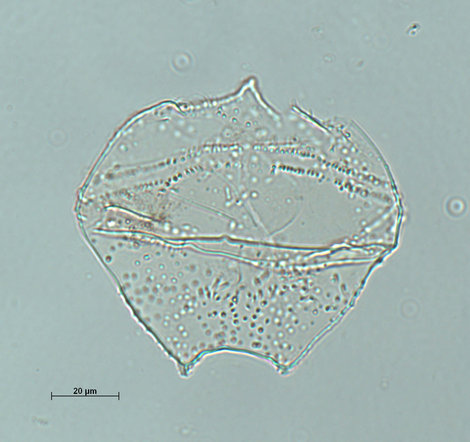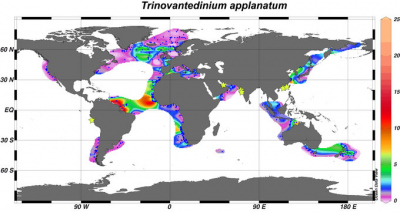Die Inhalte dieser Seite sind leider nicht auf Deutsch verfügbar.
Seitenpfad:
- Modern Dinocyst Key
- transparent cysts
- peridinioid cyst form
peridinioid cyst form
Zonneveld, K.A.F. and Pospelova V. (2015). A determination key for modern dinoflagellate cysts. Palynology 39 (3), 387- 407.
Trinovantedinium applanatum

dorsal view
Field characteristics
Trinovantedinium applanatum (Bradford 1977) Bujak et Davies 1983
Pentagonal cysts with an apical horn and two antapical lobes or horns separated by a shallow antapical sulcus. Compressed dorso-ventrally. Surface ornamented by short capitate spines and by a short bifid thickening of the wall forming an apical boss. Archeopyle intercalary and hexagonal.
Motile affinity: Protoperidinium pentagonum (Gran 1902) Balech 1974.
Cyst theca relationship: Wall and Dale, 1968
Stratigraphic range: Middle Pleistocene-Recent.
Field characteristics: Well let’s end up with an easy one. This is the only peridinioid shaped cyst that is not brown but transparent under light microscope
Pentagonal cysts with an apical horn and two antapical lobes or horns separated by a shallow antapical sulcus. Compressed dorso-ventrally. Surface ornamented by short capitate spines and by a short bifid thickening of the wall forming an apical boss. Archeopyle intercalary and hexagonal.
Motile affinity: Protoperidinium pentagonum (Gran 1902) Balech 1974.
Cyst theca relationship: Wall and Dale, 1968
Stratigraphic range: Middle Pleistocene-Recent.
Field characteristics: Well let’s end up with an easy one. This is the only peridinioid shaped cyst that is not brown but transparent under light microscope
Geographic distribution
Text and graphs from:
Zonneveld et al., 2013. Atlas of modern dinoflagellate cyst distribution based on 2405 datapoints. Review of Palaeobotany and Palynology v. 191: 1 - 197
rinovantedinium applanatum has a sub-polar to equatorial distribution and can be considered as a cosmopolitan species. Although it can be present in regions where upper water salinities are seasonally reduced, it is mainly observed in sites where full-marine conditions prevail. Highest relative abundances are observed in eutrophic environments.
Zonneveld et al., 2013. Atlas of modern dinoflagellate cyst distribution based on 2405 datapoints. Review of Palaeobotany and Palynology v. 191: 1 - 197
rinovantedinium applanatum has a sub-polar to equatorial distribution and can be considered as a cosmopolitan species. Although it can be present in regions where upper water salinities are seasonally reduced, it is mainly observed in sites where full-marine conditions prevail. Highest relative abundances are observed in eutrophic environments.

Environmental parameter range:
SST: -0.8 - 29.8°C (winter - spring), SSS: 31.1 - 39.2 (summer - summer) except for 4 sites where SSS drop to 19.1. [P]: 0.06 - 1.63 μmol/l, [N]: 0.1 - 18.5 μmol/l, chlorophyll-a: 0.1 - 20.0 ml/l, bottom water [O2]: 0.01 - 7.1 ml/l.
High relative abundances occur in oligotrophic regions and highest relative abundances upon (seasonally) eutrophic conditions. This includes upwelling areas and river-plumes, where large inter-annual variability in the trophic state can occur.
Disribution:
Trinovantedinium applanatum occurs between the polar front system in the North Atlantic and North Pacific and the sub-tropical front systems on the Southern Hemisphere. It has a cosmopolitic distribution. It generally occurs in the vicinity of the continents but sporadically also in central parts of the oceans where it is unlikely to have been transported from the shelf regions. Highest abundances (up to 20%) occur in equatorial regions notably in the the Amazon river discharge plume and the seasonal upwelling area off NW Africa. In the Amazon discharge plume area it is also observed in a few sites where upper water salinities are reduced.
Comparison with other records:
Apart from the recordings in this Atlas Trinovantedinium applanatum has been observed in coastal sediments off southern China (Wang et al., 2004c), off India and Gulf of Oman in the eastern Arabian Sea (Bradford and Wall, 1984; Godhe et al., 2000; D'Costa et al., 2008) and the Peruvian upwelling area (Biebow et al., 1993).
Sediment trap and seasonal distribution studies off NW Africa, the western Arabian Sea, and the Iberian peninsula, do not reveal a clear seasonal production pattern of T. applanatum (Zonneveld and Brummer, 2000; Ribeiro and Amorim, 2008; Zonneveld et al., 2010). However, in coastal sediments of the Iberian Peninsula, it occurs more often and in higher abundances when upwelling is absent than during intensive upwelling. In regions that are influenced by river discharge and by upwelling a positive correlation between cyst production and stratification in the upper waters has been recorded in some studies (see references in Marret and Zonneveld, 2003).
In the northern North Atlantic T. applanatum has been recorded in very few sites which experience seasonal ice cover up to 9 months a year (de Vernal et al., 1998). The relative abundance shows a strong negative correlation with sea ice cover (Radi and de Vernal, 2008).
SST: -0.8 - 29.8°C (winter - spring), SSS: 31.1 - 39.2 (summer - summer) except for 4 sites where SSS drop to 19.1. [P]: 0.06 - 1.63 μmol/l, [N]: 0.1 - 18.5 μmol/l, chlorophyll-a: 0.1 - 20.0 ml/l, bottom water [O2]: 0.01 - 7.1 ml/l.
High relative abundances occur in oligotrophic regions and highest relative abundances upon (seasonally) eutrophic conditions. This includes upwelling areas and river-plumes, where large inter-annual variability in the trophic state can occur.
Disribution:
Trinovantedinium applanatum occurs between the polar front system in the North Atlantic and North Pacific and the sub-tropical front systems on the Southern Hemisphere. It has a cosmopolitic distribution. It generally occurs in the vicinity of the continents but sporadically also in central parts of the oceans where it is unlikely to have been transported from the shelf regions. Highest abundances (up to 20%) occur in equatorial regions notably in the the Amazon river discharge plume and the seasonal upwelling area off NW Africa. In the Amazon discharge plume area it is also observed in a few sites where upper water salinities are reduced.
Comparison with other records:
Apart from the recordings in this Atlas Trinovantedinium applanatum has been observed in coastal sediments off southern China (Wang et al., 2004c), off India and Gulf of Oman in the eastern Arabian Sea (Bradford and Wall, 1984; Godhe et al., 2000; D'Costa et al., 2008) and the Peruvian upwelling area (Biebow et al., 1993).
Sediment trap and seasonal distribution studies off NW Africa, the western Arabian Sea, and the Iberian peninsula, do not reveal a clear seasonal production pattern of T. applanatum (Zonneveld and Brummer, 2000; Ribeiro and Amorim, 2008; Zonneveld et al., 2010). However, in coastal sediments of the Iberian Peninsula, it occurs more often and in higher abundances when upwelling is absent than during intensive upwelling. In regions that are influenced by river discharge and by upwelling a positive correlation between cyst production and stratification in the upper waters has been recorded in some studies (see references in Marret and Zonneveld, 2003).
In the northern North Atlantic T. applanatum has been recorded in very few sites which experience seasonal ice cover up to 9 months a year (de Vernal et al., 1998). The relative abundance shows a strong negative correlation with sea ice cover (Radi and de Vernal, 2008).


